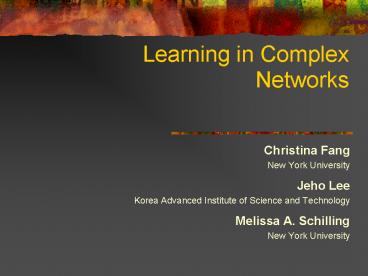Learning in Complex Networks PowerPoint PPT Presentation
1 / 14
Title: Learning in Complex Networks
1
Learning in Complex Networks
- Christina Fang
- New York University
- Jeho Lee
- Korea Advanced Institute of Science and
Technology - Melissa A. Schilling
- New York University
2
Exploration versus Exploitation in Learning
- One key way that individuals learn is through
sharing ideas with each other - Individuals that rapidly identify and adopt
higher performing ideas from others learn
efficiently - However, too rapid diffusion of higher performing
beliefs through a population eliminates variety ?
lower organizational performance in long run
(March, 1991).
3
Learning Rates and Interpersonal Structure
- Learning Rates (March, 1991)
- Fast learning results in convergence on common
set of ideas - Slow learning permits more exploration and
higher long-term performance - Interpersonal Structure
- Interpersonal structure also influences speed of
idea diffusion ? speed of convergence - Some amount of isolation may be beneficial
4
Assumptions and Research Questions
- Key Assumption of Our Work
- We extend Marchs model by assuming that
individuals learn from other individuals. - Questions
- How does organizational structure influence
organizational learning? - Is there any way to improve the balance between
learning speed and performance?
5
Interpersonal Network Structure
- Begin with a sparse clustered network, and
systematically vary rewiring rate ?
6
Simulation Model
- Individuals initially join organization with
randomly generated m-dimensional belief sets - Individuals learn probabilistically from others
to which they are directly linked - Payoff function with tunable parameter s (an
increase in s makes the search problem more
interdependent and difficult)
?(x)
where dj 1 if jth belief for an individual
corresponds with reality on that dimension, dj
0 otherwise.
7
Simulation Parameters
- Basic Model
- Individuals (n) 280
- Initial number of nearest neighbors (k) 10
- Dimensions (m) 100
- Learning rate (p) 0.3
- Sensitivity analyses run with varying levels of
s, n, k and p.
8
Learning Performance Equilibrium Outcomes
- Organizational performance highest when subgroups
are semi-isolated with a modest fraction of
cross-group links. - Is lower when subgroups are completely or
nearly isolated. - Is lower when subgroups do not exist.
- Fully connected
- Too many cross-group links
9
Graph of Results
Semi-isolated
No Sub-group Identity
Nearly-isolated
10
Diversity of Belief Sets
- Diversity is lost very quickly in fully connected
networks or networks with many cross-group links. - Diversity is lost very slowly in nearly isolated
networks. - Diversity is lost at a moderate pace in the
semi-isolated subgroup structure.
11
Dissimilarity of Belief Sets over Time
Nearly-isolated
No Sub-group Identity
Semi-isolated
12
Dissimilarity of Belief Sets over Time (without
Beta 0)
Semi-isolated
No Sub-group Identity
13
Key Findings
- Localized subpopulations (subgroup structure)
preserve heterogeneous knowledge, and foster
requisite variety for exploration (akin to
genetic drift Wright, 1932) - However, need a modest amount of cross-group
links to reap the value of this heterogeneity - Sensitivity analyses suggest a tradeoff
(compensating effect) between learning rates and
cross-group links at low levels of either
parameter.
14
Implications, Limitations, and Future Directions
- Provides support for arguments that RD groups
should be moderately isolated from others,
particularly for breakthrough innovations (Bower
Christensen, 1995) - Simulations are highly stylized models of reality
will attempt to replicate findings in
experimental setting, then field setting. - Majority rule of simulation is crucial to
outcomes future research should explore effect
of other types of decision rules.

